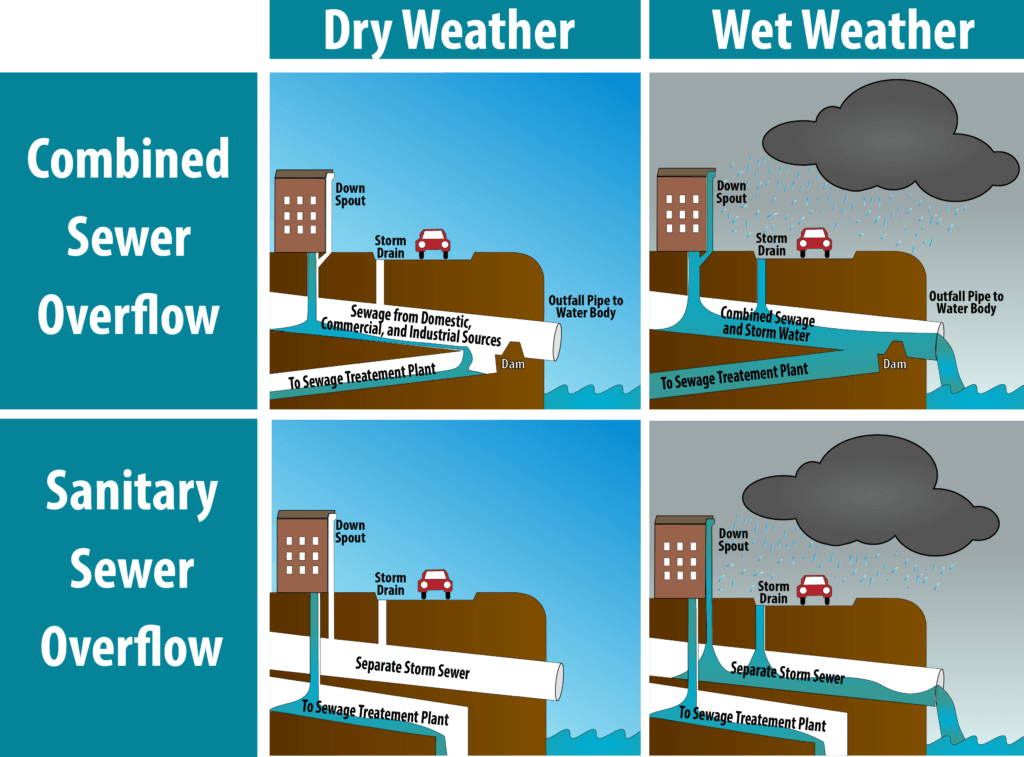MENUMENU
MENUMENU
MENUMENU
It’s important to note that stormwater sewer systems and sanitary sewer systems are often separate systems. A majority of sewer systems have two primary layouts; Combined sewer systems, and sanitary sewer systems (also called separate sewer systems). In this article, we aim to cover the major difference between these two types of systems, as well as costs and benefits to each system.
Sanitary sewers (also known as foul or covered sewers) often run to treatment plants and directly transport household and industrial wastewater. Meanwhile, street storm drains and roof drains are directed to a separate sewer line, which leads to a nearby water body. This is called a Separate Drain System, as sanitary sewage and stormwater goes to different places. These systems are far more efficient during wet weather, as stormwater can be directly deposited to a nearby water body instead of being transferred to a sewage treatment plant. This helps prevent stormwater from backing up and overflowing onto roads and other sensitive areas.

That is to say, separate sewer systems can still overflow, but in these cases, it’s primarily due to either some form of blockage in the sewer, or to some damage to piping, components, or other functions. These malfunctions can cause surcharges and backups in storm drains, often resulting in flooded streets. Immediate removal of the blockage or repairing damaged components is required to alleviate any negative effects.

The other common alternative is the Combined sewer (or drain) system, where the storm, roof, and sanitary drains all go to the same mainline which typically leads to a water treatment plant. During wet weather incidents (like heavy rain or melting snow) these systems are designed to discharge excess water to nearby water bodies. This is achieved by using dams to provide basic passive filtration. These incidents are known as Combined Sewer Overflows. Due to their design, combined sewer systems are long-lasting and sustain little damage when the system is overfilled and/or surcharges.
While these sewer systems are generally capable of filtering out debris and contaminants before reintroducing untreated water to the environment, during periods of heavy rainfall or excessive snowmelt, vast amounts of untreated water is deposited in nearby lakes, rivers, or oceans. This can lead to various negative impacts on the environment, such as chemical runoff and other various pollutants being introduced to aquatic ecosystems.
Regardless of how the sewer line is set up, these drain systems, unfortunately, require to be maintained regularly to prevent debris or other contaminants from building up. Otherwise, sewage backups or surges of sewage backflow into local water bodies can have some detrimental effects on local wildlife and human health.
Naturally, having a sanitary sewer overflow system has its benefits;
The list goes on. However, the practice is not without drawbacks. Since most combined sewer systems are remnants from legacy sewer systems, there is an extensive amount of construction required to upgrade from combined sewer overflow to a sanitary sewer system. Additionally, there’s an increased risk for the spread of pollution to nearby water bodies and the rest of the environment during the construction process. If there’s not enough rainwater during construction to help dilute any pollutants before being reintroduced into receiving water bodies, upgrading to a sanitary sewer system could have a serious impact on the environment. However, there are only about 700 cities in the United States that still have and utilize a combined sewer system, as the overall benefits of sanitary sewer systems far surpass combined sewer systems.

Regardless of what kind of sewer system is in use, one thing remains the same; to keep the system clean and fully functional, constant maintenance and monitoring are required. Buildup and blockages within the sewer system prevent the proper flow of water, building up pressure in the sewer lines. This can cause the system to surcharge, overflowing out onto the street and even breakage in the lines. Naturally, this leads polluting the nearby area with raw sewage. Needless to say, proper maintenance and cleaning are of utmost importance regardless of the system type. Separate sewer systems are more apt to sustain damage and break lines during heavy rainfall.
Cleaning a sanitary sewer system is fairly straightforward. The operator sends a cleaning nozzle upstream from one manhole to the next. The nozzle uses the water pressure from the rear jets to pull the sewer hose downstream. Meanwhile, the rear jets also scour the interior of the sanitary pipe as it’s pulled down the line. Any debris in the pipe is pulled back with the water and removed using the vacuum portion of the cleaning truck. Storm drains, catch basins, and sewer lines are all easily maintainable with various sewer cleaning machines, depending on the specific application.
Cleaning combined sewer systems are significantly more difficult. Since combined sewer lines are much larger, bigger cities tend to develop severe blockages like fatbergs (congealed fats, oils, grease, and other non-biodegradable pollutants), which must be manually displaced by sanitation workers climbing down into the system.